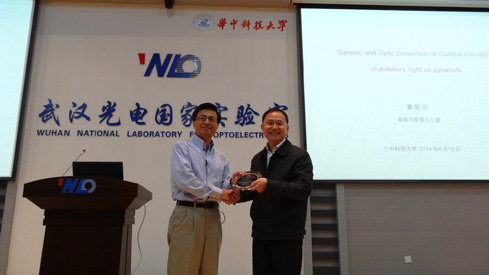WUHAN, China (April 18, 2014) - Wuhan Optoelectronics Forum No. 79 was successfully held in Auditorium A101 at Wuhan National Laboratory for Optoelectronics (WNLO) in the morning of April 18.
The mammalian neocortex gives rise to a wide range of mental activities and consists of a constellation of interconnected cortical areas, built from variations of a set of basic circuit templates. Major obstacles to understanding cortical architecture include the stunning diversity of cell types, their highly recurrent local and global connectivity, dynamic circuit operations, and a convoluted development assembly process rooted in the genome. With our increasing knowledge of gene expression and developmental genetic principles, it is now feasible to launch a genetic dissection of cortical circuits through systematic targeting of cell types and fate-mapping of neural progenitors. Strategic design of a modest number of mousedriver lines will facilitate efforts to compile a cell type parts list, build a cortical cell atlas, establish experimentalaccess to modern tools. Combined with cell resolution and brain-wide optoelectronic imaging, it is opportune to systematically discover the myriad of information processing streams and communication channels with cellular and cell type resolution.
Dr. Z. Josh Huang is currently Charles and Marie Robertson Professor of Neuroscience at the Cold Spring Harbor Laboratory in New York.He received his PhD in Cell and Molecular Biology at Brandeis University and his postdoctoral training at Massachusetts Institute of Technology.His long term research goal aims to understand the basic mechanisms underlying the developmental assembly and function organization of neural circuits in the cerebral cortex. He has pioneered the use of mouse engineering toward a genetic dissection of GABAergic inhibitory circuitry by systematically targeting distinct cell types.He is the recipient of Pew Scholar Award in Biomedical Science, McKnight Scholar Award in Neuroscience, Distinguished Investigator of NARSAD-Brain and Behavior Research Foundation, and Simon’s Investigator of Simons Foundation AutismResearch Initiative.

